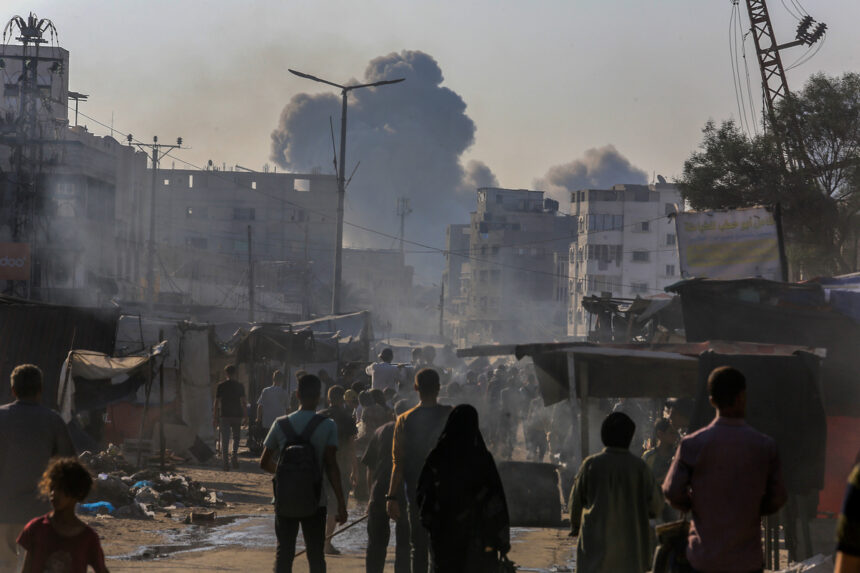As I stand at the Kerem Shalom crossing, the July heat is oppressive. Dozens of aid trucks sit motionless in long rows, engines off, drivers slumped against their wheels in resignation. This has become a familiar sight in recent weeks—vehicles loaded with vital supplies waiting for clearance that rarely comes on schedule, if at all.
“We’ve been here three days now,” explains Mahmoud, a driver who asked I use only his first name. “The food will spoil soon. This is not just bureaucracy anymore—it feels deliberate.” His truck contains flour and cooking oil destined for northern Gaza, where malnutrition rates have soared to unprecedented levels.
The current humanitarian crisis in Gaza has reached catastrophic proportions. According to the latest UN assessment, approximately 2.3 million people face severe food insecurity, with at least 500,000 people experiencing “catastrophic hunger.” The World Food Programme reports that 90% of Gaza’s population regularly goes without adequate meals, while medical facilities operate with minimal supplies.
What’s particularly troubling is the growing evidence that the aid bottleneck isn’t simply a matter of security protocols. Records from the UN Office for the Coordination of Humanitarian Affairs (OCHA) show that of the 302 aid trucks approved for entry last week, only 118 actually crossed into Gaza—the lowest weekly total since February.
Israeli officials maintain that security concerns necessitate thorough inspections. Colonel Moshe Tetro from COGAT, the Israeli military body overseeing civilian affairs in Palestinian territories, told me during a brief interview, “We understand the urgency, but we cannot compromise on security procedures that prevent weapons smuggling.”
Yet aid workers and international observers dispute this explanation. “The inspection systems have been in place for months,” says Helena Fraser, a senior humanitarian coordinator who agreed to speak on condition I not name her organization. “What we’re seeing now is increased rejection rates for items previously allowed, longer inspection times, and arbitrary new requirements that change daily.”
The situation at the crossings reflects broader diplomatic tensions. Last month’s temporary ceasefire negotiations collapsed after just three days of talks in Cairo. Since then, military operations have intensified in parts of southern Gaza, displacing thousands of civilians who had already been forced to relocate multiple times.
Walking along the perimeter of the crossing, I meet Um Rami, a Palestinian-American woman trying to coordinate medical supplies for a field hospital in Deir al-Balah. “These boxes contain antibiotics and surgical equipment,” she tells me, pointing to her small convoy. “Every day we wait, people die from treatable infections.”
The economics of this bottleneck are devastating. The World Bank estimates Gaza’s economy has contracted by 84% since October, with unemployment exceeding 80%. Infrastructure damage stands at approximately $18.5 billion—nearly triple Gaza’s annual GDP before the conflict.
What remains particularly disturbing is the growing evidence that aid restriction has become a strategic tool. Documents leaked from a mid-level security meeting suggest certain officials advocated using humanitarian access as “pressure leverage” in ceasefire negotiations—a claim Israeli government spokespeople vigorously deny.
On the ground, the consequences are stark. At Al-Aqsa Hospital, Dr. Khalil Suleiman shows me around wards where patients lie on mats on the floor. “We’re performing surgeries without anesthesia, treating burns without proper dressings,” he explains. “The medical supplies sitting at that crossing could save hundreds.”
International pressure has mounted in recent weeks. The European Union’s foreign policy chief Josep Borrell issued an unusually direct statement calling the aid restrictions “completely unacceptable and potentially in violation of international humanitarian law.” The U.S. State Department similarly expressed “profound concern” though stopped short of threatening any concrete measures.
Yesterday, I witnessed a rare moment of movement at the crossing—17 trucks were allowed through after an international delegation visited. Aid workers call this the “VIP effect”—temporary improvements during high-profile visits that quickly revert once attention shifts elsewhere.
The Israeli Supreme Court recently heard arguments challenging current aid restrictions, with human rights organizations presenting evidence that the limitation of supplies fails to meet Israel’s obligations under international law. A ruling is expected next week, though previous court decisions on humanitarian matters have faced implementation challenges.
For now, the trucks wait in the scorching heat. Supplies deteriorate. And inside Gaza, civilians face impossible choices between different forms of deprivation.
As darkness falls at Kerem Shalom, drivers prepare for another night of waiting. Some gather around small fires, sharing cigarettes and stories. “We’ll try again tomorrow,” Mahmoud tells me with forced optimism. “What else can we do?”
The calculus of suffering continues—measured in trucks that don’t move, hospitals without supplies, and a population pushed beyond what any community should endure.






